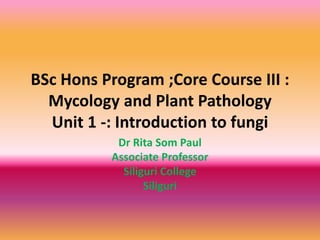
Introduction to fungi
- 1. BSc Hons Program ;Core Course III : Mycology and Plant Pathology Unit 1 -: Introduction to fungi Dr Rita Som Paul Associate Professor Siliguri College Siliguri
- 2. General characteristics • 1. Chlorophyll is absent hence they are non- photosynthetic • 2. They are heterotrophic in their mode of nutrition • 3. They are eukaryotic but sometimes also called as mesokaryotic because of their special mode of division • 4. The body does not have differentiation into different specialized parts so it is called as thallus
- 3. Affinities with plants • Both are eukaryotic thus cell structure is similar ie presence of organelles and membrane-bound nucleus • Presence of rigid cell wall around the cell • Both lack locomotion ie mobility • Both engage in relationships with other organisms – mutualistic, symbiosis, parasitism etc • External structure is similar in plants and some macrofungi (mushrooms)
- 4. Affinities with animals • Presence of chitin in the cell wall • Food storage in the form of glycogen • Formation of centrioles during cell division • Achlorophyllous • Heterotrophic • Microscopic or macroscopic in structure
- 5. Thallus (no organization into tissues/organs) structure • 1. Unicellular thallus. The body consists of a single cell. No mycelium. The vegetative and reproductive stages cannot occur in the same thallus. The whole cell changes into a reproductive structure - holocarpic fungi. Types : • With a rigid call wall in the vegetative phase Eg. Chytrids like Synchitrium spp. • No rigid cell wall in their vegetative phase. There is naked multi-nucleate, amoeboid mass of protoplasm, termed as plasmodium. Eg Slime moulds like Plasmodiophora spp.
- 6. Synchitrium (holocarpic)-rigid CW Plasmodiophora(holocarpic)- no rigid CW
- 7. Thallus…. • 2. Filamentous thallus. Most have long fine filaments called hyphae (singular hypha), which on aggregation form mycelium. During reproduction, some hyphae extend into air and give rise to reproductive structures- eucarpic fungi. Two types : • Possessing aseptate (septation i.e. compartmentalization into cells) multinucleate (innumerable nuclei present) mycelium- called as coenocytic mycelium. Eg. Lower fungi (Mastigomycotina and Zygomyctina) like Rhizopus spp., Phytophthora spp., etc. • Possessing septate mycelium i.e. multicellular filaments with usually an incomplete septum with a pore that permits exchange of protoplasm. Eg. Higher fungi like Agaricus spp., Ascobolus spp., Fusarium spp. etc.
- 8. Rhizopus (holocarpic fungus)- coenocytic mycelium Aspergillus (holocarpic fungus)- septate mycelium; multicellular
- 9. Thallus…. • 3. Pseudomycelium. Some fungi have a rigid cell wall and a single cell in their vegetative phase, but when they reproduce asexually they may form false mycelium or pseudomycelium in the form of short chain- like filamentous structures. Eg. Saccharomyces cerevisiae.
- 11. Cell Wall composition • Usually Three layers : • 1.chitin (called as fungal cellulose, polymer of N-acetyl D-glucosamine) – basic constituent in most Fungi • 2. Zymosan. (layer of b-1,3-glucan) • 3. Mannoproteins (mannose-containing glycoproteins) • Oomycetes or water moulds have the usual cellulose and glucans in their cell walls. They also have hydroxyproline (amino acid) in cell walls, not found in the true fungi. • Note : A new group of fungi, Cryptomycota , does not have chitin in their cell wall at all. This a highly diverse group of unculturable fungi ( Jones et al, 2011).
- 12. Nutrition • Fungi depend on external sources for their growth and development- heterotrophs (hetero – others, trophy – food). Types : • 1. Obligate parasites or biotrophs – the fungi that need to get into a suitable host in order to live and reproduce, but they may or may not cause a disease. Definitely, they will cause a discomfort to the plant or animal. These are seldom fatal, because these fungi depend on their host for survival and it will not be in their interest to kill the host. They cannot be cultured on synthetic media. Most of the obligate fungal parasites that have been discovered , are pathogens i. e. they do cause disease. Eg. Erysiphe causes powdery mildew, Puccinia causes rust.
- 13. Nutrition…. • 2. Facultative parasites – do not need a living host in order to survive, but they may occasionally infect a suitable host and live as parasites. Eg. Fusarium spp, Botrytis cinerea are the usual residents of soil and infect hosts under suitable conditions.
- 14. Nutrition… • 3. Obligate saprophyte or necrotroph – The fungi that live only on dead and decaying matter and never infect a living organism. Eg. Agaricus spp.
- 15. Nutrition… • 4. Facultative saprophyte – These usually prefer a living host for their development and reproduction. However, they can survive on dead organic remains also and can be grown on artificial media in laboratory. Eg. Phytophthora infestans. •
- 16. Nutrition…. • 5. Symbiont – A fungus enters into a mutually beneficial relationship. Eg. Lichen – a partnership with an alga. Mycorrhiza – partnership of fungi with roots of higher plants.
- 17. Taxonomic position and Classification R. H. Wittaker (1969). According to his five-kingdom concept, Monera includes unicellular prokaryotes (bacteria and cyanobacteria), Protista – unicellular eukaryotes (microalgae and protozoa), Mychota (or Mycota)– yeast and moulds, Plantae – true plants , Animalia – true animals. In 1996, Lynn Margulis, an eminent evolutionary biologist, stated that molecular biology, life history and fossil record evidence support the reunification of bacteria as Prokaryota while subdivision Eukaryota into uniquely defined subtaxa : Protoctista (unicellular eukaryotes), Animalia, Fungi and Plantae.